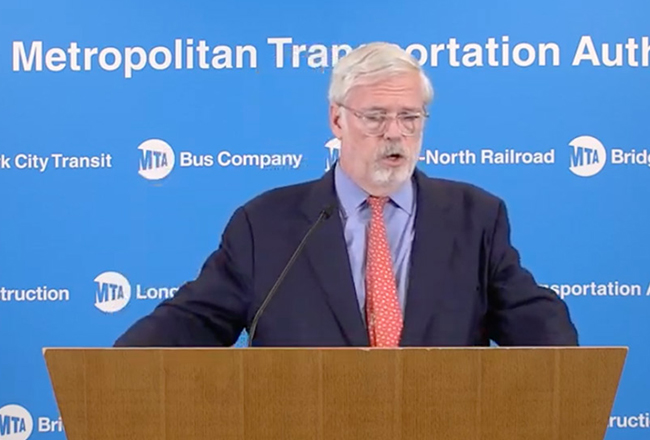MTA board considers laying off 9,000, massive service cuts
Metropolitan Transportation Authority Chairman Patrick Joseph Foye said this afternoon at the MTA’s Manhattan headquarters that the possibility of dramatic service cuts and layoffs is very real unless the agency receives the $12 billion of federal funding it has been seeking for months.
Under consideration by the MTA’s board are service cuts of up to 50% and laying off more than 9,000 workers including about 1,000 who work for the Metro-North Railroad and the Long Island Rail Road.

Cuts also would be made affecting the New York City buses and subways along with MTA bridges and tunnels. The board met today and received presentations outlining plans to slash service across the board coupled with commensurate layoffs if new funding cannot be found.
“Only the federal government can come to the rescue at the level of funding that we require,” Foye said. “It’s a national crisis requiring a national solution.”
He expressed the hope that when the new Joe Biden administration takes office, Washington would finally answer the MTA’s repeated calls for help. Foye said that there are no plans for the MTA to file bankruptcy if it did not receive sufficient funding because it has contractual obligations to its bondholders not to take such action.
Foye spoke with reporters after the board meeting at which documents were presented that projected a cumulative deficit of $15.9 billion through 2024. Without federal aid, deficit reduction options include cuts in operations, eliminating 9,367 workers and instituting permanent wage freezes for those MTA employees who remain.
“Railroad service reductions of up to 50% may result in full or partial suspension of service on both weekdays and weekends,” a document reads. “Peak service may be reduced to every 20-30 minutes or hourly in certain instances. Off-peak and weekend service may be hourly, reflecting current ridership levels while maintaining enough service to prevent crowding.”
The consulting firm McKinsey projected for the MTA that after the Covid-19 pandemic has been brought under control, ridership will remain lower than before the pandemic, with “new normal ridership” peaking at only 80% to 92% of pre-pandemic levels.
“Ridership is down dramatically. We’re not only in a pandemic but a fiscal, financial, tsunami faces the MTA,” Foye said today. “Right now we’re providing more service than the current level of ridership demands. We do assume that ridership will increase although if McKinsey is right, and they’ve been pretty close on the analysis they’ve done for the MTA in the last six or nine months, ridership will increase and the expectation is that as needed we would increase service from the levels that have been cut but that’s not going to happen instantly.”
Foye said that the MTA does not expect to be given a blank check and the agency does not want to have to resort to increasing fares given the current environment where many New Yorkers are hurting financially.
“We’re very hopeful and believe that the new administration will have a far more enlightened view,” Foye said.
Foye said that the MTA has just cut $2.2 billion in planned spending and knocked out planned spending for 2021 by another $600 million. It will reduce overtime spending by $213 million, consulting contracts by $118 million and nonpersonnel expenses by $270 million. It is also looking at cutting another $150 million in operating expenses. Despite this, however, the possibility of new service and personnel cuts is very real according to Foye.
“It’s important to us when we go and talk to lenders, bond buyers and also elected officials that the MTA is engaged in self-help and doing everything it can from a business point of view to reduce the deficit and the amount that has to be provided by federal funding,” Foye said.